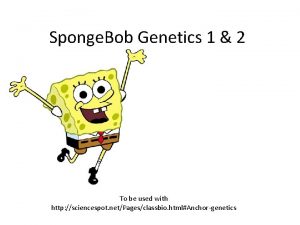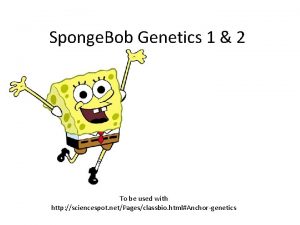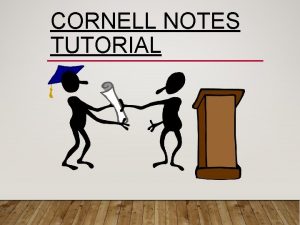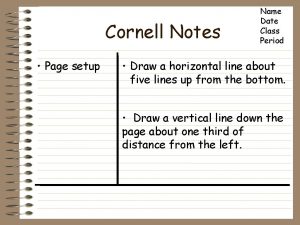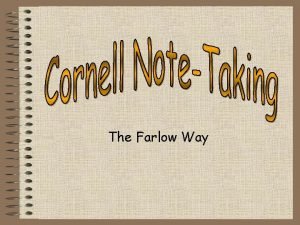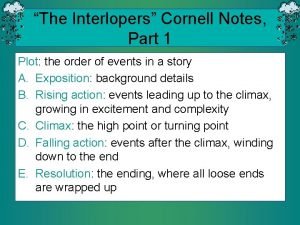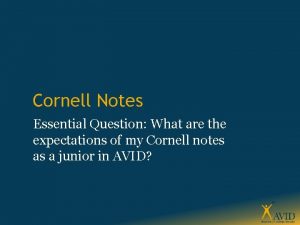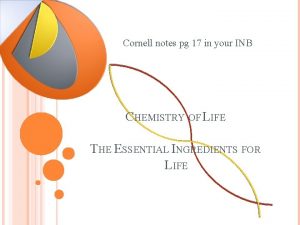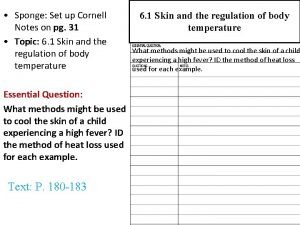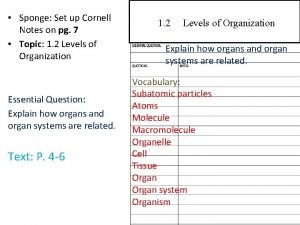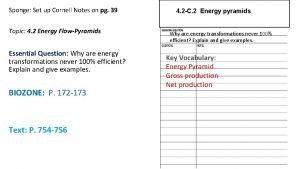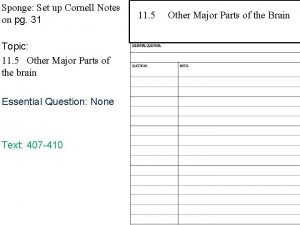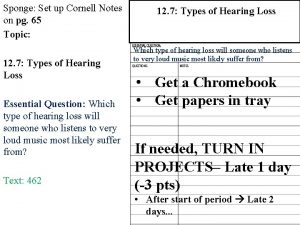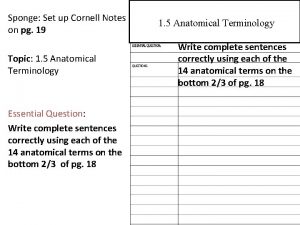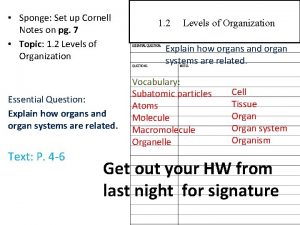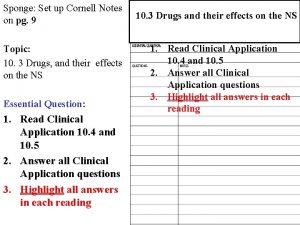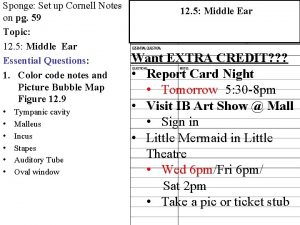Sponge Set up Cornell Notes on p 75
































- Slides: 32

Sponge: Set up Cornell Notes on p. 75 Topic: 9. 3 Muscular Responses & Actions Essential Question: Text: 298 -301 9. 3 Atoms, Muscular 2. 1 Ions, and Molecules Responses & Actions Describe how connective tissue is associated with a skeletal muscle.

Threshold Stimulus A muscle fiber will remain unresponsive until a certain strength of simulation is reached Threshold stimulus: the strength of stimulation needed for contraction • Action potential will be generated • Muscle impulse generated • Fiber contracts

Recording of a muscle contraction The contractile response of a single muscle fiber is called a twitch • Period of contraction during which the fiber pulls at its attachments • Followed by a period of relaxation, during which pulling declines A series of twitches

Recording of a muscle contraction All-or-none response: When a muscle fiber is brought to threshold under a given set of conditions, it tends to contract completely, such that each twitch generates the same force • This is misleading, however, because in normal muscles, the force generated by muscle fibers must vary otherwise we would only have one amount of strength

Recording of a muscle contraction A single muscle fiber contraction by itself is of little significance to day-to-day activities In order to perform everyday activities we require a few things: • The contribution of multiple muscle fibers simultaneously • A sustained contraction of a whole muscle • Control of contraction force

Recording of a muscle contraction Ex: Holding a Styrofoam cup of coffee firmly enough that it doesn't slip through your fingers, but not so forcefully that we crush it This requires precise control of contractile forces

Summation A muscle fiber exposed to a series of stimuli of increasing frequency reaches a point when it is unable to completely relax before the next stimulus in the series arrives • When this happens, the individual twitches begin to combine by the process of summation

Summation A tetanic contraction is when the resulting forceful, sustained contraction lacks even partial relaxation

Recruitment of motor units The number of muscle fibers in a motor unit varies considerably: A whole muscle is composed of many motor units controlled by different motor neurons

Recruitment of motor units The fewer muscle fibers in the motor units, the more precise the movements that can be produced in a particular muscle Ex: The muscles that move the eyes may include fewer than 10 muscle fibers per motor unit and can produce very slight movements

Recruitment of motor units Ex: The motor unites of the large muscles of the back may include 100 or more muscle fibers. When these motor units are stimulated, the movements that result are less gradual compared to the eye

Recruitment of motor units Since the muscle fibers within a muscle are organized into motor units and each motor units is controlled by a single motor neuron, all the muscle fibers in a motor unit are stimulated at the same time If only the more easily stimulated motor neurons are involved, few motor units contract

Recruitment of motor units Recruitment: At higher intensities of stimulation, other motor neurons respond, and more motor units are activated

Sustained Contractions During sustained contractions: • Smaller motor units are recruited earlier • Large motor units respond later and with more force The result is a sustained contraction of increasing strength

Sustained Contractions Ex: When a person lifts a weight or walks, sustained contractions are maintained in the upper limb or lower limb muscle for varying lengths of time

Sustained Contractions Even when a muscle appears to be at rest, a certain degree of sustained contraction occurs in its fibers. Muscle tone is an example of an involuntary partial sustained contraction • Important for maintain posture • Tautness in the muscles of the neck, trunk, and lower limbs enables a person to hold the head upright, stand, or sit • If tone is suddenly lost, such as when a person loses consciousness, the body collapses • Muscle tone is maintained in health but is lost if motor nerve axons are cut of it diseases interfere with conduction of nerve impulses

Fast- and Slow-Twitch Muscle Fibers Muscle fibers vary in contraction speed

Fast- and Slow-Twitch Muscle Fibers Slow-twitch fibers (type I) • Resistant to fatigue • Often called red fibers because they contain the red, oxygen-storing pigment myoglobin • Well supplied with O 2 -carrying blood • Contain many mitochondria • Can generate ATP fast enough to keep up with ATP breakdown • Can contract for long periods of time without fatigue • Activities such as swimming and running are most likely to stimulate the development of slow-twitch fibers • Ex: those found in the long muscles of the back

Fast- and Slow-Twitch Muscle Fibers Fast-twitch fibers (type II) maybe fatigable or fatigue resistance • Type II a • Called white fibers because they have less myoglobin • Poor blood supply • Ex: certain hand muscles that move the eyes • Few mitochondria • Can form ATP faster than red fibers, but because of their ability to contract rapidly, they fatigue as lactic acid accumulates • Type II b • Have fast twitch-speed but have substantial O 2 capacity, more characteristic of red fibers

Fast- and Slow-Twitch Muscle Fibers All muscles include a combination of both fiber types (fast/slow-twitch) The speed of contraction and aerobic capacities of the fibers reflect the specialized functions of the muscle Ex: Muscles that move the eye contract about 10 x faster than those that maintain posture Ex: The muscles that move the limbs contract at intermediate rates

Fast v. Slow Twitch Muscle Fibers 2 m 5 s • https: //www. youtube. com/watch? v=3 x. Tjnwo 2 S 2 A

Crash Course: Muscles Part 2 • https: //www. youtube. com/watch? v=I 80 Xx 7 p. A 9 h. Q&t=272 s

Sponge: Set up Cornell Notes on p. 77 Topic: 9. 4 Skeletal Muscle Actions Essential Question: Text: 9. 4 Skeletal 2. 1 Atoms, Ions, Muscle and Molecules Actions Describe how connective tissue is associated with a skeletal muscle.

Levers and Movement *

Skeletal Muscle Actions Skeletal muscles generate a great variety of body movements. The action of each muscle mostly depends upon: • the kind of joint it is associated with and the way the muscle is attached on either side of that joint • The context of a particular movement

Body Movement Whenever limbs or other body parts move, bones and muscles interact as simple mechanical devices called levers

Body Movement Ex: A pair of scissors is a lever • The handle/blade form a rigid bar that rocks on a fulcrum near the center (screw) • The material to be cut by the blades represents the resistance • While the person on the handle end supplies the force needed for cutting the material

Body Movement The actions of bending and straightening the upper limb at the elbow illustrate bones and muscles function as levers When the upper limb bends, the forearm bones represent the rigid bar The elbow joint is the fulcrum The hand is moved against the resistance provided by the weight The force is supplied by muscles on the anterior side of the arm

Origin an Insertion One end of a skeletal muscle is usually fastened to a relatively immovable or fixed part, and the other end is connected to a movable part of on the other side of a joint Origin: The immovable end of muscle Insertion: The moveable end of a muscle When a muscle contracts, its insertion is pulled towards its origin The head of a muscle is the part nearest its origin

Origin an Insertion Some muscles have more than one origin or insertion Ex: Biceps brachii has two origins (bi=two) When the biceps brachii contracts, its insertion is pulled toward its origin, and the elbow bends

Interaction of Skeletal Muscles Skeletal muscles almost always function in groups As a result, when a particular body part moves, a person must do more than contract a single muscle Instead, after learning to make a particular movement, the person wills the movement to occur, and the nervous system stimulates the appropriate group of muscles

Interaction of Skeletal Muscles By carefully observing body movements, it is possible to determine the roles of particular muscles Ex:
 Bikini bottom genetics worksheet
Bikini bottom genetics worksheet Sponge susie roundpants
Sponge susie roundpants How to set up cornell notes
How to set up cornell notes Total set awareness set consideration set
Total set awareness set consideration set Training set validation set test set
Training set validation set test set 4 parts of cornell notes
4 parts of cornell notes Cornell notes the interlopers
Cornell notes the interlopers Textual evidence synonym
Textual evidence synonym Cornell notes steps
Cornell notes steps Cornell notes chemistry
Cornell notes chemistry Biology cornell notes
Biology cornell notes Note taking legend
Note taking legend Declaration of independence cornell notes
Declaration of independence cornell notes Cornell notes rubric
Cornell notes rubric Cornell notes setup
Cornell notes setup Ions and ionic bonding cornell doodle notes
Ions and ionic bonding cornell doodle notes Cornell notes setup
Cornell notes setup Cornell notes setup
Cornell notes setup Metric system cornell notes
Metric system cornell notes The interlopers short story summary
The interlopers short story summary What do cornell notes look like
What do cornell notes look like Essential question cornell notes
Essential question cornell notes How does cornell notes work
How does cornell notes work Cornell notes setup
Cornell notes setup What is the essential question in cornell notes
What is the essential question in cornell notes Chemistry cornell notes
Chemistry cornell notes Walter pauk cornell
Walter pauk cornell What do cornell notes look like
What do cornell notes look like Thinking apu
Thinking apu Cornell notes for anatomy and physiology
Cornell notes for anatomy and physiology Cornell notes advantages
Cornell notes advantages Cornell note setup
Cornell note setup Cornell notes sociology
Cornell notes sociology
